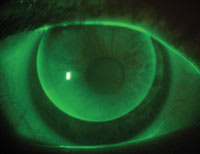GP insights
Prescribing
GP Lenses in a Material World
BY
JOHN MARK JACKSON, OD, MS, FAAO
With so many great designs and materials available, there's never been a better time to fit GP lenses. But a quick look at the long list of available materials can make even a seasoned GP fitter pause. With such a wide variety available, how do you choose the right material for each patient?
|
|
|
The right fit is important, but the right material will help ensure successful GP wear for this patient. |
Factors to Consider
Sometimes the choice of material is restricted by the lens design. For example, the Visions lens from X-Cel is available only in Paragon HDS material. But if you do have a choice of material, some factors can help you determine the best choice.
Dk The Dk of a lens material is likely the first consideration for most clinicians. For simplicity, let's define low Dk as about 30 units, medium Dk at about 60 units and high Dk at about 100 or more. Most lenses fall into these general categories.
Research by Cavanagh et al at Baylor University suggests that high-Dk materials help prevent bacterial binding to the cornea, potentially decreasing the risk of infection. A high-Dk material is certainly desirable from this standpoint.
Surface Characteristics However, lens surface characteristics are also critical in GP fitting. Lens wettability is very important for comfort and clear vision. As a rule, lower-Dk lenses wet better than do higher-Dk lenses. Lower-Dk lenses tend to be more durable, they can be manufactured thinner and they flex less, deposit less and scratch less. We need to balance the need for high Dk with these factors to provide the best choice. So how can we decide?
Recommendations
First, I like to go modern. Manufacturers have and continue to put a great deal of effort into the newest generation of lenses to improve Dk while keeping desirable surfaces. Use the most recent versions of materials and don't be timid about trying new ones as they're introduced. Patients appreciate knowing that you're using the latest technology in all aspects of their eye care, including their lens material.
Second, I aim for the mid-Dk range for most daily wear patients to provide a balance between oxygen permeability and lens wettability. Exceptions would include extended wear (use high-Dk materials), high-minus and plus powers (use high-Dk materials because the lenses are thicker), keratoconus (use lower-Dk materials for thinness and easy cleaning) and corneal grafts (high-Dk materials). I tend to use Paragon HDS and Boston EO (Bausch & Lomb) as my workhorse materials, and I've also had success with Optimum Comfort (Contamac).
Third, no matter what material you choose, have your lab use the new plasma treatment to increase initial wettability. I was skeptical with the process at first, but I've been pleased with the results.
Conclusion
These guidelines are from my own clinical experience and training, and your mileage may vary. You need to tailor your choice to each of your patients based on their history and needs. Also, take advantage of your GP lab's expertise and ask for their guidance. The end result will be happy, comfortable patients.
Dr. Jackson is an assistant professor at Southern College of Optometry where he works in the Advanced Contact Lens Service, teaches courses in contact lenses and performs clinical research.




